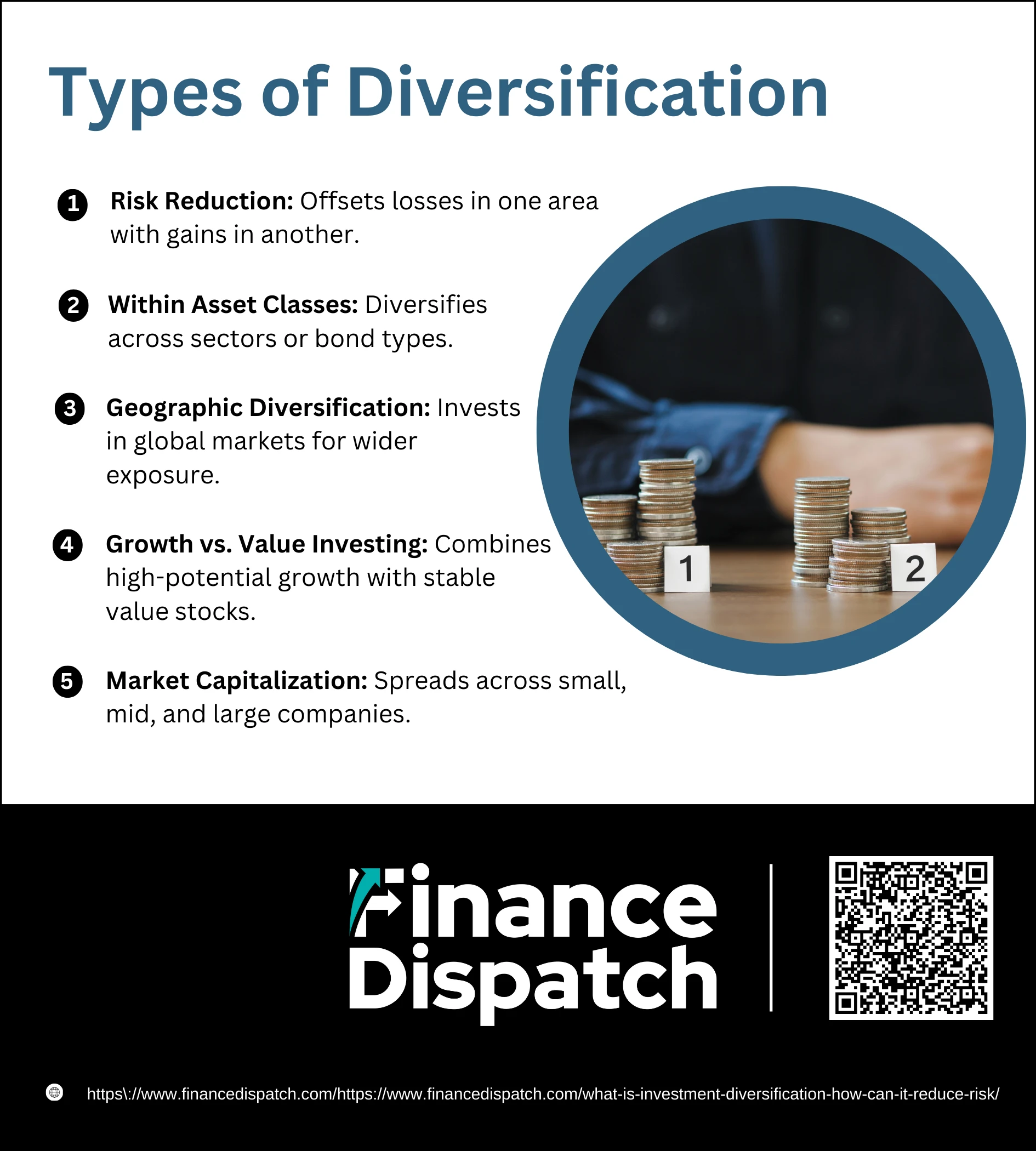Investing is never without risk. Markets rise and fall, companies succeed and fail, and entire industries can be shaken by unexpected events. If all your money is tied to a single stock, sector, or asset, one downturn could cause significant losses. This is where investment diversification comes in. Diversification is the practice of spreading your investments across different asset classes, industries, and regions to balance risk and reward. Instead of depending on one source, a diversified portfolio allows strong performers to offset weaker ones, creating more stability over time. While diversification doesn’t guarantee profits or eliminate risk altogether, it is one of the most effective strategies to smooth out market volatility and protect your long-term financial goals.
What is Investment Diversification?
Investment diversification is a strategy used to manage risk by spreading money across different types of assets rather than relying on a single investment. Instead of putting all your capital into one stock, bond, or sector, you combine a mix of equities, bonds, real estate, cash, and sometimes alternative assets like commodities. Each asset class responds differently to economic changes—when one performs poorly, another may hold steady or even grow. This balance helps protect your overall portfolio from sharp losses, smooths out returns over time, and keeps your investments aligned with long-term financial goals
 How Diversification Works
How Diversification Works
Diversification works by creating a portfolio that balances different types of investments so that overall risk is reduced. Instead of depending on a single asset, investors spread their money across a range of asset classes, industries, and time horizons. This approach doesn’t eliminate risk completely, but it helps stabilize returns and reduces the likelihood of severe losses when markets fluctuate.
1. Risk Reduction
When all your money is tied to one investment, a downturn in that asset can cause significant damage. Diversification spreads risk by ensuring that poor performance in one area can be offset by stronger performance in another. For example, if technology stocks decline, your holdings in healthcare or bonds may still perform well, helping to balance out the losses.
2. Variety of Assets
A well-diversified portfolio usually includes a mix of asset classes such as equities, bonds, real estate, commodities, and cash. Each asset type reacts differently to economic events. Stocks might grow rapidly during an economic expansion, while bonds often provide stability during downturns. By holding a variety of assets, you reduce reliance on any one market outcome.
3. Portfolio Stability
Diversification helps manage what is called “unsystematic risk”—the risks that affect specific companies or industries. By holding investments across different sectors and markets, the ups and downs of individual assets average out, leading to more consistent overall portfolio performance. This stability is particularly valuable during periods of market turbulence.
4. Time Horizons
Not all investments have the same maturity period. Some are short-term, like cash equivalents or Treasury bills, while others, like real estate or long-term bonds, require years to realize returns. Mixing assets with different time horizons allows you to maintain liquidity for short-term needs while also pursuing growth opportunities for the long term. This balance makes your portfolio more adaptable to changing financial goals.
 Types of Diversification
Types of Diversification
Diversification isn’t a single strategy—it comes in different forms. Investors spread their money across various asset classes, industries, geographies, and company sizes to avoid being overly dependent on one area. By combining multiple types of diversification, you can build a stronger portfolio that weathers different market conditions.
1. Across Asset Classes
The most common form of diversification is holding different types of assets such as stocks, bonds, real estate, commodities, and cash. Each reacts uniquely to market changes. For instance, when stocks fall during a recession, government bonds often gain value, and commodities like gold may act as a safe haven. By mixing these classes, your portfolio has built-in protection against sudden market downturns.
2. Within Asset Classes
Even within a single group of investments, it’s wise to diversify further. In stocks, this might mean investing across different sectors—technology, healthcare, energy, or consumer goods—so that a downturn in one sector doesn’t harm your entire portfolio. Similarly, bond diversification might involve mixing short-term and long-term maturities or choosing between corporate, municipal, and government bonds. This reduces reliance on any one segment.
3. Geographic Diversification
Markets don’t move in the same direction worldwide. An investor who only holds domestic assets risks losing heavily if their local economy falters. By adding international stocks or global funds, you gain exposure to regions that may perform better. For example, if the U.S. market slows down, Asian or European equities might help balance your overall returns.
4. Growth vs. Value Investing
Growth stocks belong to companies expected to expand rapidly, often in emerging industries like technology. They offer high potential but also carry volatility. Value stocks, on the other hand, are more established companies trading below their perceived worth, offering stability and sometimes dividends. Holding both growth and value stocks ensures that you benefit from innovation while still maintaining a cushion of safety.
5. Market Capitalization
Companies are categorized by size: small-cap, mid-cap, and large-cap. Large-cap firms (like Apple or Microsoft) are stable and less risky, while small-cap companies may grow faster but are also more vulnerable to downturns. Mid-cap stocks provide a balance of both. Including all three sizes spreads risk and captures opportunities across the growth spectrum.
 How Diversification Reduces Risk
How Diversification Reduces Risk
Diversification reduces risk by making sure your portfolio isn’t dependent on a single investment, company, or market to succeed. Since different assets react differently to economic changes, spreading your money across them creates a safety net. This way, when one part of your portfolio struggles, another can help offset the losses, keeping your long-term financial goals on track.
1. Offsets Losses with Gains
In any given year, not all investments move in the same direction. For example, if technology stocks fall because of regulatory changes, your holdings in government bonds or utilities may remain steady or even rise. This balancing effect means that your portfolio as a whole doesn’t experience as sharp a decline as it would if you held only tech stocks.
2. Protects Against Sector Downturns
Economic challenges often hit specific industries harder than others. During the dot-com crash in the early 2000s, many internet-based companies collapsed, but investors who also held healthcare, consumer staples, or industrial stocks were better positioned to withstand the losses. By diversifying across industries, you avoid tying your fortunes to just one sector’s performance.
3. Balances Market Cycles
Markets go through phases of expansion and contraction. Stocks usually perform best during periods of economic growth, while bonds tend to do better during recessions when investors seek stability. Commodities like gold often rise when inflation is high. A mix of these assets allows your portfolio to capture gains in one area while softening losses in another, helping you ride through market cycles more smoothly.
4. Reduces Company-Specific Risk
Even strong companies face risks like leadership changes, product recalls, or lawsuits. For example, if you only owned shares in one airline, a pilots’ strike could slash the value of your portfolio. But if you also held stocks in railways, technology, and consumer goods, the impact would be limited. Diversifying across companies ensures no single event devastates your wealth.
5. Manages Geographic Risks
Political instability, economic recessions, or currency fluctuations can drag down an entire country’s market. By investing internationally—say, combining U.S. stocks with Asian or European funds—you reduce the chance that a downturn in one country wipes out your gains. Global diversification spreads your risk across multiple economies, some of which may be growing while others slow down.
Benefits of Diversification
Diversification is more than just a defensive move—it’s a strategy that supports long-term financial success. By holding a variety of assets, you create balance, protect your capital, and increase the chances of steady growth even when markets fluctuate.
- Reduces overall risk – Losses in one investment can be offset by gains in others, lowering the impact of volatility.
- Provides portfolio stability – A mix of assets smooths out returns over time, avoiding extreme highs and lows.
- Protects capital – Diversification ensures that no single failure can wipe out your wealth.
- Enhances opportunities – Spreading across industries, sectors, and regions opens the door to more growth potential.
- Improves risk-adjusted returns – Balancing high-risk and low-risk investments can optimize both safety and performance.
- Encourages discipline – A diversified portfolio helps investors stay focused on long-term goals instead of reacting emotionally to short-term market swings.
Risks and Limitations of Diversification
While diversification is a powerful tool to manage risk, it isn’t foolproof. Spreading your investments too widely or without strategy can reduce potential gains and add complexity. It’s important to understand both the strengths and the shortcomings of diversification so you can apply it wisely.
- Over-diversification may dilute returns – Holding too many investments can cancel out the benefits of high-performing assets.
- Increased monitoring and complexity – A larger, more varied portfolio requires more effort to track and rebalance.
- Higher transaction costs – Buying and selling multiple assets to maintain diversification can eat into returns.
- Potential missed opportunities – Spreading investments too thin may cause you to overlook big gains in a concentrated sector.
- Correlation risk – If assets are more closely linked than expected (e.g., during a global crisis), diversification may fail to protect against losses.
- Need for expertise – Without proper knowledge, investors may diversify ineffectively, creating a portfolio that looks balanced but still carries hidden risks.
Measuring Diversification
Diversification is easy to understand in theory but harder to measure in practice. Since a portfolio may contain many different assets, investors and analysts use specific tools and indicators to estimate how well-diversified an investment mix really is. These measures don’t eliminate risk but help assess whether a portfolio is balanced or too concentrated.
| Method | What It Measures | How It Helps Investors |
| Correlation Coefficient | Relationship between two assets (ranges from -1 to 1) | Shows whether assets move together (+1), independently (0), or in opposite directions (-1). Strong negative correlation improves diversification. |
| Standard Deviation (SD) | Volatility of asset returns compared to the average | Higher SD = more risk and fluctuation. Helps compare how risky different investments are. |
| Weighting/Counting | Percentage or number of assets in a portfolio | Ensures no single asset or class dominates the portfolio. For example: 60% stocks, 30% bonds, 10% alternatives. |
Practical Strategies to Diversify Your Portfolio
Diversifying your portfolio doesn’t have to be complicated. The key is to spread your investments across different areas that behave differently under various market conditions. By applying a few practical strategies, you can reduce risk, improve stability, and align your investments with long-term goals.
- Spread Across Asset Classes
Invest in a balanced mix of stocks, bonds, real estate, commodities, and cash equivalents. Each reacts differently to market events, so combining them cushions overall risk. - Diversify Within Asset Classes
Within stocks, invest across sectors like technology, healthcare, energy, and consumer goods. In bonds, balance between government, corporate, and municipal options with varied maturities. - Consider Geographic Diversification
Don’t rely solely on your home country’s economy. International investments provide exposure to global growth and protect against local downturns. - Balance Growth and Value Stocks
Growth stocks offer higher potential but with more volatility, while value stocks provide stability and dividends. Mixing both can smooth portfolio performance. - Use Investment Funds and ETFs
Mutual funds and exchange-traded funds (ETFs) pool multiple assets, giving you instant diversification at a lower cost than buying each investment individually. - Rebalance Periodically
Over time, some assets grow faster than others, shifting your portfolio’s balance. Regular rebalancing ensures your investments stay aligned with your goals and risk tolerance.
Conclusion
Diversification is one of the most reliable ways to protect your investments from unexpected market swings. By spreading your money across different asset classes, industries, and regions, you reduce the impact of any single loss and create more stable, long-term growth. While it cannot eliminate risk entirely, diversification helps balance safety with opportunity, giving you the confidence to stay focused on your financial goals. A well-diversified portfolio is not about chasing the highest returns—it’s about building resilience, preserving capital, and staying prepared for whatever the market brings.



